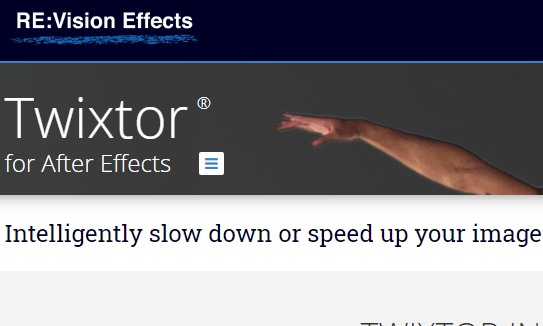

- #Twixtor vs optical flow how to#
- #Twixtor vs optical flow pro#
- #Twixtor vs optical flow software#
- #Twixtor vs optical flow series#
For precise retiming, you can try a plugin like Twixtor that will essentially do the same thing as Optical Flow but at a higher level.
#Twixtor vs optical flow software#
If you frequently work with slow motion and high frame rate cameras, it could be worth it to invest in software designed specifically for the task. The more detail and movement Premiere has to interpret the more likely something will be off. For best results, shoot against a simple, static background.
#Twixtor vs optical flow pro#
Render.īut Optical Flow isn’t perfect-because Premiere Pro is generating entirely new frames, some issues like warping and artifacting can occur. Right-click and choose Time Interpolation > Optical Flow. Using Optical Flow to smooth a speed ramp is just a little bit different. After making this change, you’ll have to render the footage before playing it back. To enable Optical Flow when using the Speed/Duration controls, change the Time Interpolation to Optical Flow. You can really see the difference at the beginning of the clip when the dancer goes up on pointe.

Compare with this example, using Optical Flow. When using Frame Sampling, Premiere Pro duplicates existing frames to create the slow motion effect. Let’s look at an example of slow motion created using the Speed/Duration module with the default Time Interpolation (Frame Sampling): The result is smooth rather than choppy motion. When enabled, Premiere Pro will use existing frames to intelligently generate new frames to go in between your existing ones. The Optical Flow feature can help smooth your slow motion effect to make it look more like you shot at a higher frame rate. Play around with the ramp until you’re happy with the look. Use the Bezier handles to smooth the effect further. To smooth the ramp, click and drag your keyframe to split it. Click and drag that middle section up for fast motion, down for slow motion.Īt this point, the speed change is abrupt. Command + Click (Mac) or Control + Click (PC) the band to create keyframes. For an effect where the speed ramps up or down to highlight a motion and then resumes normal speed, you’ll need to create two keyframes, essentially separating the clip into three sections. To create a progressive speed change you’ll need to add keyframes. Dragging the band up and down will adjust the speed (and in turn, the duration) of the entire clip. Right-click the clip, and select Show Clip Keyframes > Time Remapping > Speed.Ī horizontal band appears that controls the speed of the clip. Here’s an example using this clip of a dancer:īefore getting started, click and drag to increase the height of the video track you’ll be working with, so you can see what you’re doing in the next steps. Speed ramping is the process of progressively changing the speed of a clip over time. Speed and Duration adjustments in Adobe Premiere Pro are great for a quick and dirty job: a clip that only needs a slight adjustment, a stylized look, or making something shot in slow motion even slower. To adjust speed or duration independently without affecting the other parameter, click the Gang button, so it looks like a broken link. For example, 50% will play your clip back at half the speed of the original, doubling the duration of the clip.Īlternatively, if you know you want your clip to be a specific duration, type that into the Duration section, and Premiere will adjust the speed accordingly. To slow down your clip, type a percentage lower than 100%. Simply right-click a clip and choose Speed/Duration. In Adobe Premiere Pro, the Speed/Duration module is the easiest way to create slow motion video.
#Twixtor vs optical flow how to#
Here we’ll look at some tricks to get the best possible manufactured slow motion in Premiere Pro, plus learn how to create speed ramping effects. To get that really extreme slow motion effect, you’ll need a specialty camera to achieve it.īut what if you’ve already shot your footage at a lower frame rate, you’re working with stock video, or you just need to figure this out in the editing phase? If you’re in any of these situations, this tutorial is for you. Ideally, you’ll shoot your footage at a high frame rate (and fortunately most cameras will have the option to shoot between 60 and 240fps). Shooting video at 60fps, for example, will yield slow motion playback. You can create slow motion when the shooting frame rate is higher than the playback frame rate (read: greater than 30fps!).
#Twixtor vs optical flow series#
So let’s back it up: a moving image is a series of still images (frames) played back in a sequence, typically at the frame rate of 24fps or 30fps.

Before diving into speed effects in Adobe Premiere Pro, it’s mission-critical to understand exactly what slow motion is.


 0 kommentar(er)
0 kommentar(er)
